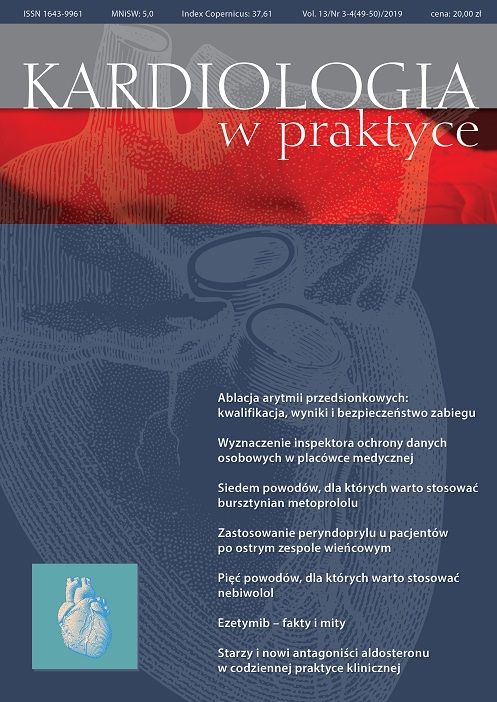Ablation of atrial arrhythmia: indications, outcomes and safety Review article
Main Article Content
Abstract
Taking into account cotemporary knowledge and available equipment, current clinical guidelines indicate catheter ablation as a treatment of choice (class I A) in most of recurrent atrial arrhythmias especially those resistant to pharmacotherapy. Effectiveness and safety of ablation depend both on the index arrhythmia and experience of the operator/center. Patients with documented narrow QRS tachycardias (especially typical atrial flutter) should be considered for electrophysiological consultation due to high chance of a successful and curative procedure.
Downloads
Article Details

This work is licensed under a Creative Commons Attribution-NonCommercial 4.0 International License.
Copyright: © Medical Education sp. z o.o. This is an Open Access article distributed under the terms of the Attribution-NonCommercial 4.0 International (CC BY-NC 4.0). License (https://creativecommons.org/licenses/by-nc/4.0/), allowing third parties to copy and redistribute the material in any medium or format and to remix, transform, and build upon the material, provided the original work is properly cited and states its license.
Address reprint requests to: Medical Education, Marcin Kuźma (marcin.kuzma@mededu.pl)
References
2. Brugada J., Katritsis D.G., Arbelo E. et al.; ESC Scientific Document Group: 2019 ESC Guidelines for the management of patients with supraventricular tachycardia The Task Force for the management of patients with supraventricular tachycardia of the European Society of Cardiology (ESC). Eur Heart J. 2019 Aug 31. pii: ehz467.
3. Spector P., Reynolds M.R., Calkins H. et al.: Meta-analysis of ablation of atrial flutter and supraventricular tachycardia. Am. J. Cardiol. 2009; 104(5): 671-677.
4. Farkowski M.M., Pytkowski M., Maciag A. et al.: Gender-related differences in outcomes and resource utilization in patients undergoing radiofrequency ablation of supraventricular tachycardia: results from Patients’ Perspective on Radiofrequency Catheter Ablation of AVRT and AVNRT Study. Europace 2014; 16(12): 1821-1827.
5. Kuck K.H., Brugada J., Fürnkranz A. et al.; FIRE AND ICE Investigators: Cryoballoon or Radiofrequency Ablation for Paroxysmal Atrial Fibrillation. N. Engl. J. Med. 2016; 374(23): 2235-2245.
6. Farkowski M.M., Pytkowski M., Sterliński M.: Wpływ współistniejących chorób wewnętrznych na efektywność zabiegu ablacji podłoża migotania przedsionków. WDR 2014; 31(2): 22-24.

